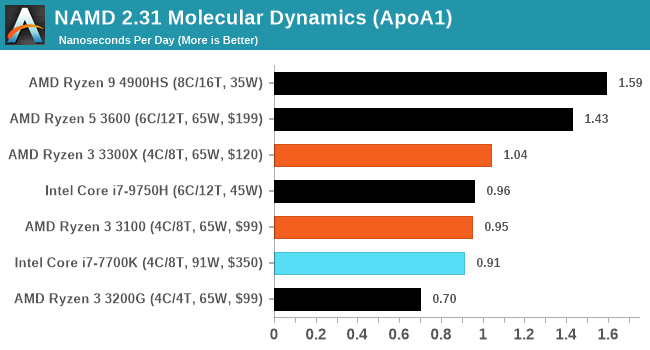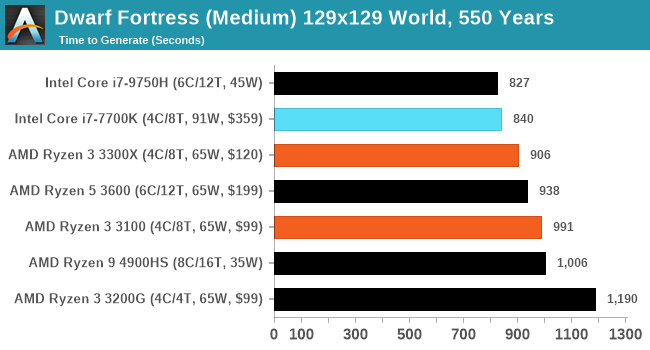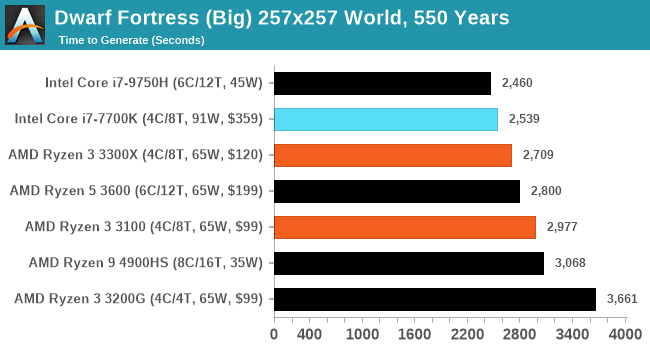The AMD Ryzen 3 3300X and 3100 CPU Review: A Budget Gaming Bonanza
by Dr. Ian Cutress on May 7, 2020 9:00 AM ESTCPU Performance: New Tests!
As part of our ever on-going march towards a better rounded view of the performance of these processors, we have a few new tests for you that we’ve been cooking in the lab. Some of these new benchmarks provide obvious talking points, others are just a bit of fun. Most of them are so new we’ve only run them on a few processors so far. It will be interesting to hear your feedback!
NAMD ApoA1
One frequent request over the years has been for some form of molecular dynamics simulation. Molecular dynamics forms the basis of a lot of computational biology and chemistry when modeling specific molecules, enabling researchers to find low energy configurations or potential active binding sites, especially when looking at larger proteins. We’re using the NAMD software here, or Nanoscale Molecular Dynamics, often cited for its parallel efficiency. Unfortunately the version we’re using is limited to 64 threads on Windows, but we can still use it to analyze our processors. We’re simulating the ApoA1 protein for 10 minutes, and reporting back the ‘nanoseconds per day’ that our processor can simulate. Molecular dynamics is so complex that yes, you can spend a day simply calculating a nanosecond of molecular movement.

Crysis CPU Render
One of the most oft used memes in computer gaming is ‘Can It Run Crysis?’. The original 2007 game, built in the Crytek engine by Crytek, was heralded as a computationally complex title for the hardware at the time and several years after, suggesting that a user needed graphics hardware from the future in order to run it. Fast forward over a decade, and the game runs fairly easily on modern GPUs, but we can also apply the same concept to pure CPU rendering – can the CPU render Crysis? Since 64 core processors entered the market, one can dream. We built a benchmark to see whether the hardware can.
Smooth#canitruncrysis pic.twitter.com/k7x31ULndF
— 𝐷𝑟. 𝐼𝑎𝑛 𝐶𝑢𝑡𝑟𝑒𝑠𝑠 (@IanCutress) May 4, 2020
For this test, we’re running Crysis’ own GPU benchmark, but in CPU render mode. This is a 2000 frame test, which we run over a series of resolutions from 800x600 up to 1920x1080.
| Crysis CPU Render Frames Per Second |
||||||
| AnandTech | 800 x600 |
1024 x768 |
1280 x800 |
1366 x768 |
1600 x900 |
1920 x1080 |
| AMD | ||||||
| Ryzen 9 4900HS | 11.50 | 8.75 | 7.44 | 6.83 | 5.21 | 4.30 |
| Ryzen 5 3600 | 9.98 | 7.84 | 6.69 | 6.15 | 4.75 | 3.92 |
| Ryzen 3 3300X | 8.42 | 6.52 | 5.43 | 5.01 | 3.92 | 3.07 |
| Ryzen 3 3100 | 7.50 | 5.78 | 4.87 | 4.5 | 3.54 | 2.77 |
| Intel | ||||||
| Core i7-7700K | 7.63 | 5.87 | 4.95 | 4.55 | 3.57 | 2.79 |
| Core i7-9750H | 6.78 | 5.17 | 4.37 | 3.99 | 3.12 | 2.46 |
Dwarf Fortress
Another long standing request for our benchmark suite has been Dwarf Fortress, a popular management/roguelike indie video game, first launched in 2006. Emulating the ASCII interfaces of old, this title is a rather complex beast, which can generate environments subject to millennia of rule, famous faces, peasants, and key historical figures and events. The further you get into the game, depending on the size of the world, the slower it becomes.
DFMark is a benchmark built by vorsgren on the Bay12Forums that gives two different modes built on DFHack: world generation and embark. These tests can be configured, but range anywhere from 3 minutes to several hours. I’ve barely scratched the surface here, but after analyzing the test, we ended up going for three different world generation sizes.



Interestingly Intel's hardware likes Dwarf Fortress.
We also have other benchmarks in the wings, such as AI Benchmark (ETH), LINPACK, and V-Ray, however they still require a bit of tweaking to get working it seems.










249 Comments
View All Comments
psychobriggsy - Thursday, May 7, 2020 - link
They'll be based off on Renoir. So 8 cores, 16 threads, with 8MB L3.In mobile, Renoir's GPU has outperformed the predecessor, despite having fewer CUs, because of improved clocks. I'd say it's likely desktop Renoir will outperform the predecessor in graphics at the same price point, but not dramatically.
Namisecond - Thursday, May 7, 2020 - link
So, if we go by mobile Renoir, a max of 8 CU graphics?lightningz71 - Friday, May 8, 2020 - link
Yes, but, it was trivially easy to run the 3400g gpu at 1600mhz and run the ram at 3400/3600 speeds. Assuming that the gpu of the “4400” apu gets 8CUs at about 2000 MHz, it will have less total processing power. Assuming that it can’t typically run the ram much faster than 4000 speeds, it won’t have much extra bandwidth. My best guesstimate is that it performs marginally better than the 3400 in gpu limited tasks purely for having better ram support and less processor memory contention due to the larger L3. However, games are rarely entirely gpu limited and having the much improved zen 2 cores will make things markedly better.I base a lot of that on the benchmarks of the 3500u vs the 4500u, which are very roughly comparable in resources. The 4500u is consistently faster, though not by much.
Spunjji - Monday, May 11, 2020 - link
I'm expecting much the same as what you outlined here. A significant improvement over the 3400G in CPU performance and gaming for stock configurations, but with limited gains over overclocked systems.Koenig168 - Thursday, May 7, 2020 - link
Hmmm ... the 3300X is doing better than I thought it would. Would appreciate some benchmarks with games that benefit from more cores/threads. Great article. I find the part about the difference between 3100 and 3300X particularly interesting (I had wondered about the difference between the two CPUs to warrant the price difference).EdgeOfDetroit - Thursday, May 7, 2020 - link
Do those games actually exist?eastcoast_pete - Friday, May 8, 2020 - link
The 3300 is a fully functional 4 cores on one die, the 3100 is 2 cores on two (otherwise defective) die. Thus, the 3100 needs to use the interconnect a lot, which slows it down a bit.extide - Saturday, May 9, 2020 - link
No, it's still a single die, just spread across both CCX in that die instead of just one.extide - Saturday, May 9, 2020 - link
(But otherwise yes you're correct because even within a single CCD the cores must travel out to the IO die and back to get to the other CCX)Deicidium369 - Friday, May 8, 2020 - link
Suggest 3 or 4